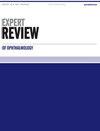Donor scleral graft vs pericardial graft vs scleral flap in tube drainage covering: advantages and disadvantages
IF 0.9
Q4 OPHTHALMOLOGY
引用次数: 0
Abstract
ABSTRACT Introduction Glaucoma drainage devices (GDD) have become very popular in the surgical management of patients with glaucoma. Areas covered One of the important steps in GDD surgery is the tube coverage, in order to avoid the occurrence of postoperative tube exposure which carries the risk of infectious endophthalmitis. Several patch graft materials or autologous scleral procedures have been proposed, of which the donor scleral graft, pericardial graft, and scleral flap are among the most frequently adopted. We aimed to provide a comprehensive review of the literature on this topic, with a focus on the material and characteristics, surgical technique, and advantages and disadvantages of each of these three common options. Expert opinion Both donor scleral grafts and scleral flaps provide a low and similar rate of postoperative tube exposure and low costs. The scleral flap procedure is readily available but may carry the risk of intraoperative complications and corneal issues related to scleral biomechanical changes. Pericardial grafts are associated with higher rates of graft thinning and tube exposure.供体巩膜移植物、心包移植物和巩膜瓣在管引流覆盖中的优缺点
青光眼引流装置(GDD)在青光眼患者的外科治疗中非常流行。覆盖区域GDD手术的重要步骤之一是管覆盖,以避免术后管暴露的发生,从而带来感染性眼内炎的风险。已有几种膜片移植材料或自体巩膜手术被提出,其中最常采用的是供体巩膜移植、心包移植和巩膜瓣。我们的目的是对这一主题的文献进行全面的回顾,重点是材料和特征,手术技术,以及这三种常见选择的优缺点。专家意见供体巩膜移植物和巩膜瓣都提供了低且相似的术后管暴露率和低成本。巩膜瓣手术很容易获得,但可能存在术中并发症和与巩膜生物力学变化相关的角膜问题的风险。心包移植与较高的移植物变薄和导管暴露率相关。
本文章由计算机程序翻译,如有差异,请以英文原文为准。
求助全文
约1分钟内获得全文
求助全文
来源期刊

Expert Review of Ophthalmology
Health Professions-Optometry
CiteScore
1.40
自引率
0.00%
发文量
39
期刊介绍:
The worldwide problem of visual impairment is set to increase, as we are seeing increased longevity in developed countries. This will produce a crisis in vision care unless concerted action is taken. The substantial value that ophthalmic interventions confer to patients with eye diseases has led to intense research efforts in this area in recent years, with corresponding improvements in treatment, ophthalmic instrumentation and surgical techniques. As a result, the future for ophthalmology holds great promise as further exciting and innovative developments unfold.
 求助内容:
求助内容: 应助结果提醒方式:
应助结果提醒方式:


